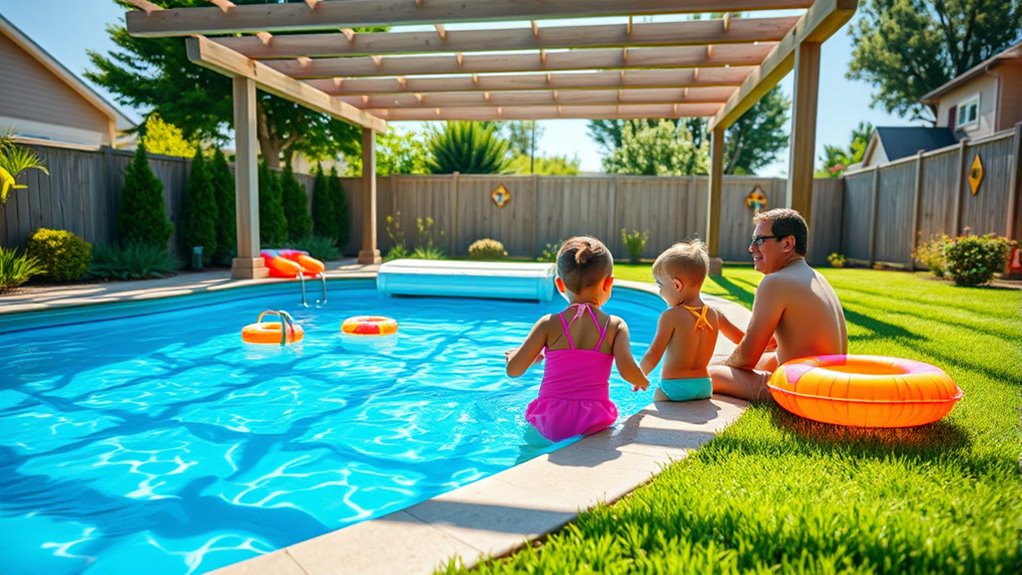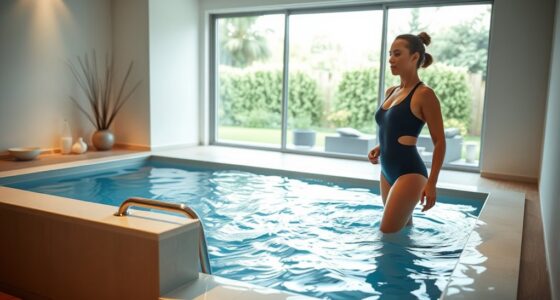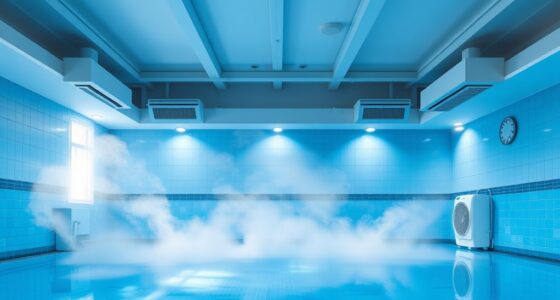To keep your family safe around an endless pool, always supervise children closely, never leave them unattended, and enforce clear rules like no running or rough play. Install sturdy barriers and covers, and make sure safe entry and exit points like ladders or steps. Keep emergency equipment nearby and regularly check water quality and equipment. Monitor weather conditions and avoid pool use during storms. Staying vigilant with these safety measures helps protect everyone — discover more tips to guarantee safety for all.
Key Takeaways
- Always supervise children and inexperienced swimmers, keeping them within arm’s reach and avoiding distractions during pool use.
- Install secure fencing, safety covers, and barriers to prevent unauthorized access and accidental falls.
- Enforce pool rules such as no running, diving, or rough play, and educate all users about safe behavior.
- Regularly inspect and maintain pool equipment, water quality, and safety devices to ensure a safe swimming environment.
- Monitor weather conditions and ensure safe entry/exit points with non-slip surfaces and sturdy handrails.
Supervise Children at All Times

Because accidents can happen quickly, supervising children at all times when they are near or in the pool is essential. You need to stay attentive and avoid distractions like phones or conversations. Keep children within your sightline, and don’t rely solely on safety devices or floaties; they’re not foolproof. Assign a dedicated adult to watch the kids whenever they’re in or around the water. Establish clear rules, such as no running or diving, and enforce them consistently. Remember, even confident swimmers can get into trouble unexpectedly. Stay vigilant, especially with younger children who may not understand water dangers. Your active supervision can prevent accidents before they happen, ensuring everyone stays safe and enjoys the pool responsibly. Incorporating positive mindset strategies can also help foster a calm and focused attitude during supervision, reducing the risk of oversight.
Install Proper Safety Barriers and Covers
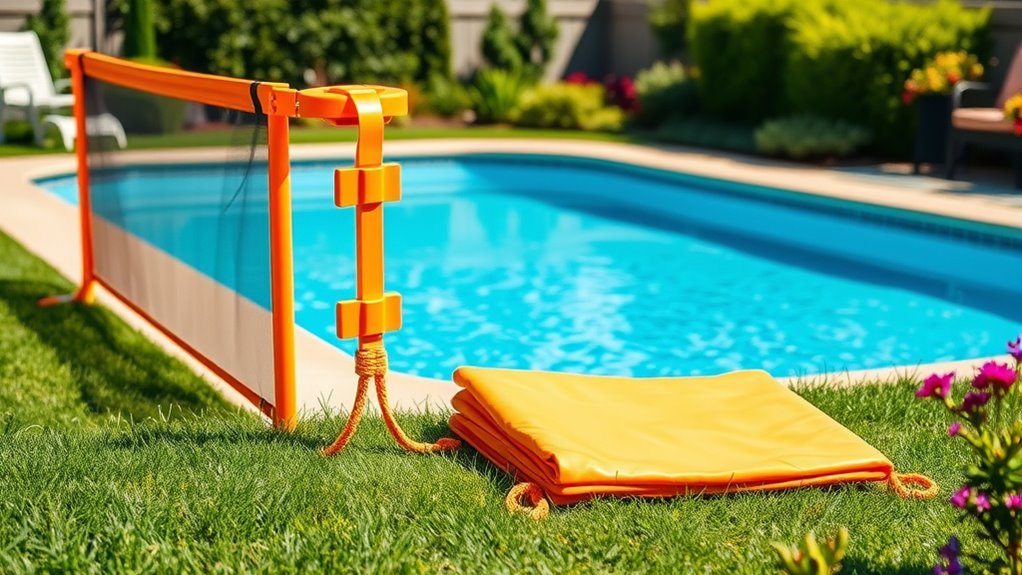
Installing proper safety barriers and covers around your pool creates a strong line of defense against accidental entry. A sturdy fence at least four feet high with a self-closing, self-latching gate keeps children and pets out when you’re not supervising. Ensure the fence is difficult to climb and that gaps are small enough to prevent slipping through. Pool covers should be secure, durable, and rated for safety, so they can support weight if someone accidentally steps on them. Always use covers that are in good condition and properly fitted to prevent accidental falls or drownings. Regularly inspect barriers and covers for damage or wear, replacing them as needed. These safety measures provide peace of mind and considerably reduce the risk of pool-related accidents. Incorporating vertical storage solutions can also help keep pool equipment and safety gear organized and accessible, further enhancing safety around your pool area.
Educate Family Members About Pool Rules
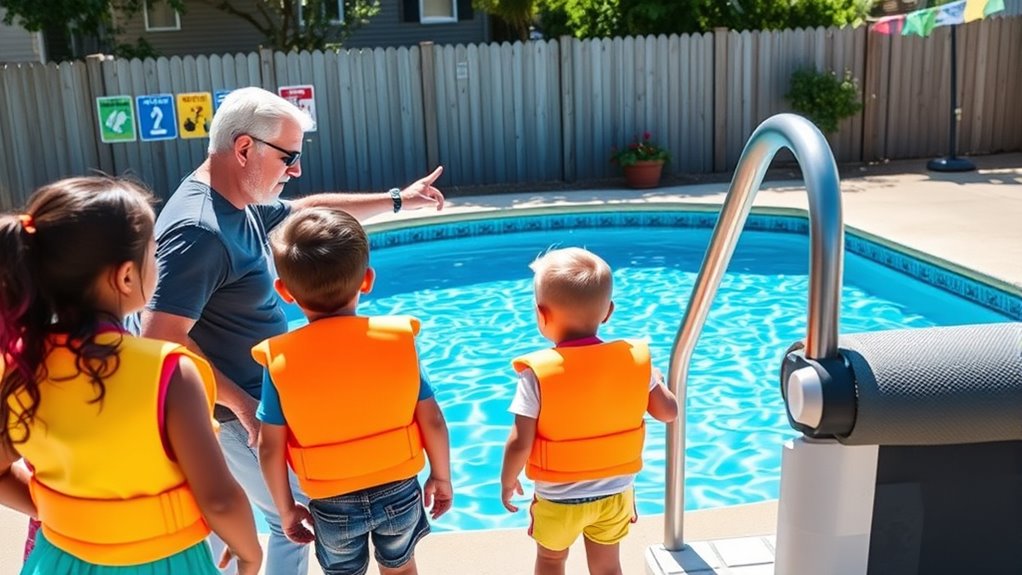
You need to make sure everyone understands the pool rules before they use the pool. Constant supervision is essential, especially when kids are nearby, and establishing clear no-run zones helps prevent accidents. Teaching safe entering techniques also keeps everyone safer and encourages responsible behavior around the pool. Incorporating AI-powered virtual reality training can also help family members learn pool safety skills in an engaging and interactive way.
Supervise Constantly During Use
Constant supervision is essential whenever the pool is in use, as accidents can happen in an instant. Always keep a close eye on family members, especially children. Designate a responsible adult to oversee at all times, even if others are present. Make sure everyone understands pool rules and follows them diligently. To help you stay alert, consider creating a visual reminder or schedule. Here’s a quick guide to keep in mind:
| Supervision Tip | Why It Matters | Example |
|---|---|---|
| Stay within arm’s reach | Prevents quick accidents | Keep children close when swimming |
| Avoid distractions | Ensures focus on safety | No phone use while supervising |
| Assign a designated supervisor | Keeps constant watch | One adult watches all kids |
| Watch for risky behaviors | Reduces injury chances | No running or rough play |
| Use safety equipment | Provides extra protection | Life jackets or pool alarms |
Additionally, regularly checking pool equipment ensures that safety devices are functioning properly and can be relied upon in an emergency.
Establish Clear No-Run Zones
To prevent accidents around the pool, establishing clear no-run zones is essential. You should mark areas where running is prohibited with visible signs or bright tape. Make sure everyone understands that rushing or running near the pool increases the risk of slips and falls. Remind family members to walk slowly and carefully, especially on wet surfaces. Enforce these rules consistently to create a safe environment. Keep children informed about the no-run zones each time they use the pool. Consider setting boundaries with physical barriers or visual cues to reinforce the rules. Clear communication and visible markers help everyone remember to stay cautious, reducing the chance of slips and injuries. Additionally, understanding the importance of contrast ratio can help you select the safest and most suitable pool lighting and surfaces to improve visibility. Staying vigilant ensures that pool time remains fun and safe for everyone involved.
Teach Safe Entering Techniques
Educating family members about safe entering techniques is essential for preventing accidents around the pool. When showing others how to enter correctly, emphasize the importance of using steps or ladder entries instead of jumping or diving. Always remind everyone to check the water depth before entering and avoid rushing. To promote safe habits, consider these tips:
- Enter the pool slowly and carefully, holding onto handrails if available
- Avoid running or pushing others while entering
- Make sure the pool area is clear of obstacles before stepping in
- Use a professional voiceover style when creating safety instructions to ensure clarity and engagement.
Keep Emergency Equipment Nearby
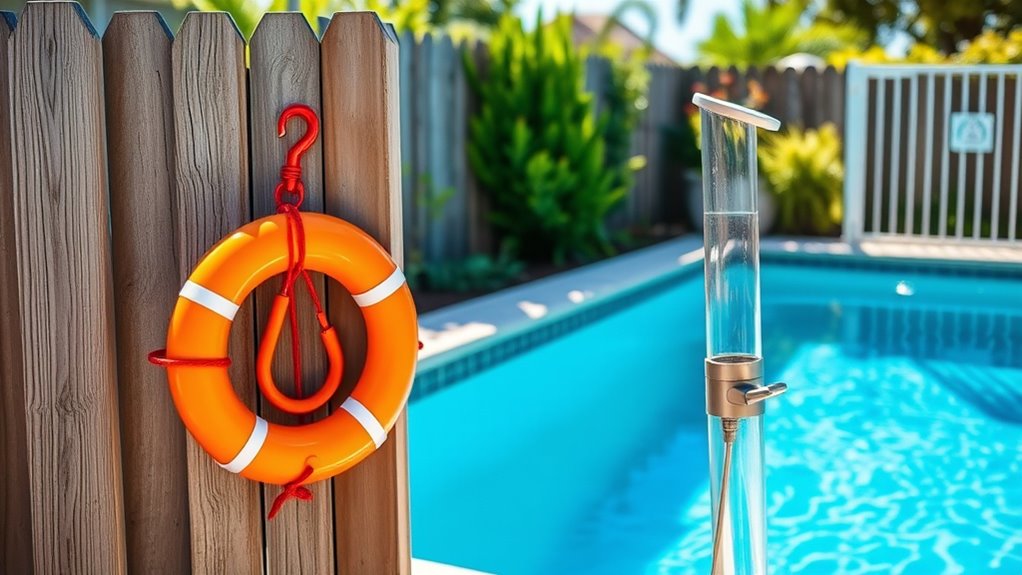
Make sure rescue tools are within arm’s reach in case of an emergency, so you can respond quickly. Keep a clear emergency plan posted nearby to guide everyone on what to do if something goes wrong. Being prepared with accessible equipment and a plan can make all the difference in a crisis. Additionally, regularly reviewing and practicing your safety procedures helps ensure everyone knows how to act swiftly and confidently during an emergency. Emergency preparedness
Accessible Rescue Tools
Having emergency rescue tools nearby is essential for quickly assisting anyone who might be in trouble in the pool. When seconds count, accessible equipment can make all the difference. Keep items within arm’s reach and guarantee everyone knows their location. Consider having a reaching pole or shepherd’s hook ready to extend and grab someone in distress. A life ring or floatation device can provide immediate support until help arrives. Additionally, keep a waterproof, easily accessible cell phone nearby to call emergency services if needed. Regularly check that all rescue tools are in good condition and within easy reach. By maintaining this setup, you reduce response time and increase safety for everyone in or around your pool. Incorporating sustainable safety equipment can also contribute to eco-friendly pool safety practices.
Clear Emergency Plan
A well-organized emergency plan includes keeping rescue equipment within easy reach and ensuring everyone knows its location. You should place life rings, reaching poles, and a first aid kit close to the pool area. Make sure all family members understand how to use this equipment quickly in an emergency. Practice your plan regularly, so everyone reacts calmly and efficiently. Post clear signs indicating where rescue tools are stored. Keep your phone nearby to call emergency services immediately if needed. Having a designated person responsible for calling help can save valuable time. Remember, quick access to rescue tools can make a critical difference. By preparing ahead, you create a safer environment and reduce panic during an emergency.
Maintain Water Quality and Cleanliness
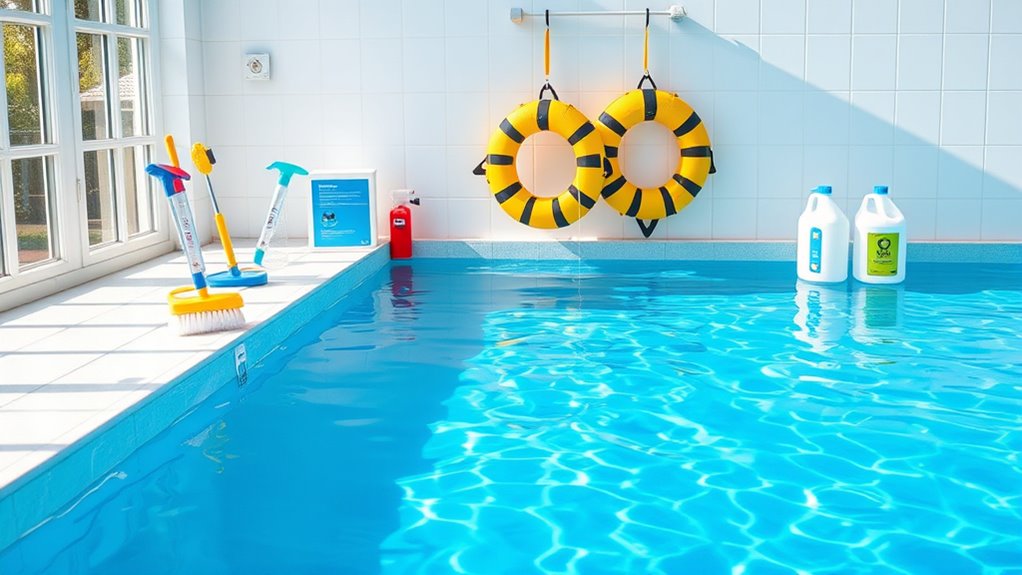
To keep your endless pool safe and inviting, maintaining water quality and cleanliness is essential. Regularly testing your water ensures proper pH levels, chlorine or sanitizer balance, and alkalinity. Clean water prevents algae and bacteria growth, reducing health risks. Also, skimming debris and vacuuming the pool weekly keeps the water clear and free of dirt. Using an air purifier can further improve indoor air quality around your pool area, helping to remove airborne contaminants that may affect respiratory health. Here are key steps to maintain water quality: – Test water chemistry at least twice a week using a reliable test kit – Adjust chemical levels promptly to stay within safe ranges – Clean filters regularly to ensure they’re functioning properly
Regularly Inspect Pool Equipment and Surroundings
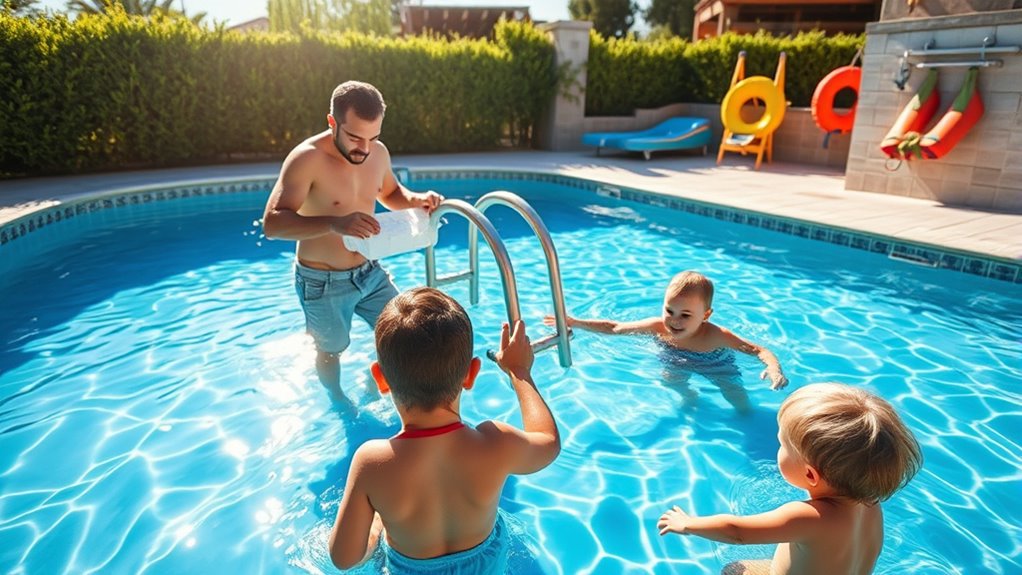
Regular inspections of your pool equipment and surroundings are essential for safety and efficient operation. Check filters, pumps, and heaters for leaks, corrosion, or unusual noises. Ensure safety covers and fences are secure and undamaged. Regularly clean skimmers and inspect for blockages to maintain proper circulation. Keep an eye out for damaged tiles or cracks around the pool area that could cause injuries. Here’s a quick overview:
| Equipment | Condition to Watch For | Action Needed |
|---|---|---|
| Pool Pump | Leaks, strange noises | Repair or replace as necessary |
| Filters | Clogs, wear | Clean or replace |
| Safety Fences & Covers | Damage, looseness | Repair or secure |
| Surrounding Tiles | Cracks, sharp edges | Repair or replace |
Consistent inspections help prevent accidents and costly repairs.
Establish Clear Usage Guidelines and Limits
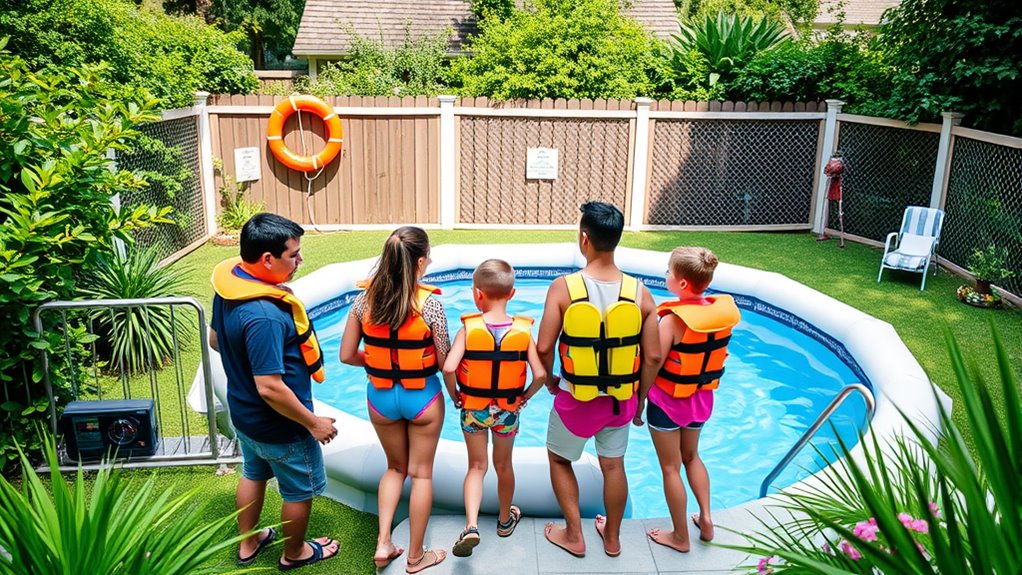
Maintaining a safe pool environment involves more than just inspecting equipment; it also requires setting clear rules for its use. You should define who can use the pool and when, ensuring everyone understands the boundaries. Establish limits on pool time for children to prevent overexposure and fatigue. Additionally, set rules about behavior, such as no running or roughhousing around the pool area. Clearly communicate these guidelines to all family members and visitors, and enforce them consistently. This helps create a safe, respectful environment where everyone understands the expectations. Remember, consistent rules reduce accidents and ensure that pool time remains fun and safe for everyone involved. Establishing proper supervision is essential to prevent accidents and provide immediate assistance if needed. Clear guidelines are the foundation of a secure and enjoyable swimming experience.
Ensure Safe Entry and Exit Points
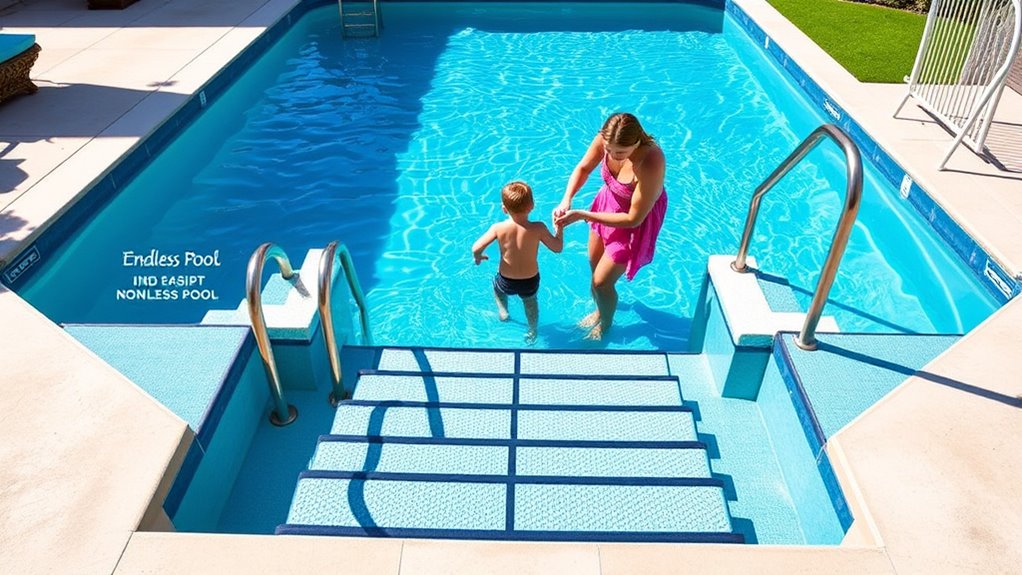
Ensuring safe entry and exit points around your endless pool is crucial to prevent accidents and injuries. Make sure steps, ladders, or access points are sturdy, non-slip, and securely attached. Regularly inspect these areas for wear or damage, replacing them if necessary. Keep the surrounding deck clear of clutter and obstacles to reduce tripping hazards. Consider installing handrails or grab bars near entry points to provide extra support, especially for children or seniors. Always encourage family members to enter and exit slowly and carefully. If your pool has steps, ensure they are visible and well-lit at night. By maintaining clear, secure, and stable entry and exit points, you help create a safer environment for everyone using your endless pool.
Monitor Weather Conditions and Avoid Use During Storms

Monitoring weather conditions is essential to keep everyone safe around your endless pool. Storms can bring lightning, strong winds, and heavy rain, creating dangerous situations. Before swimming, check the weather forecast and stay alert for sudden changes. If you see darkening skies or hear thunder, it’s time to get out. Never use your pool during storms, especially when lightning is nearby, as water conducts electricity and increases the risk of electrocution.
Always monitor weather conditions and avoid swimming during storms to stay safe around your pool.
To stay safe, remember to:
- Regularly check weather updates before and during pool use
- Avoid swimming if thunderstorms are approaching or present
- Keep the pool covered or drained during severe weather
Your vigilance can prevent accidents and ensure a safe swimming environment for everyone.
Frequently Asked Questions
How Can I Teach Young Children to Swim Safely?
You can teach young children to swim safely by always supervising them closely and never leaving them unattended near water. Start with basic skills in a controlled environment, like an endless pool, and use age-appropriate floatation devices. Encourage them to learn floating, treading water, and safe entry and exit techniques. Reinforce safety rules consistently, and make certain they understand the importance of never swimming alone or in unsafe conditions.
What Are the Best Signs Indicating Water Safety Hazards?
Think of water hazards as hidden monsters lurking beneath the surface. You’ll spot warning signs like cloudy or murky water, strong currents, or unexpected waves. Also, be alert for broken or missing safety equipment, fences, or alarms. If you notice these, it’s a clear sign to stay away and address the hazards immediately. Always trust your instincts—safety signs and conditions are your best guides to keeping everyone safe.
How Often Should Pool Safety Equipment Be Inspected?
You should inspect your pool safety equipment monthly to guarantee it’s in good working condition. Check for any signs of damage, corrosion, or wear, and replace or repair items as needed. Regular inspections help prevent accidents and ensure safety devices like life rings, reaching poles, and alarms function properly when needed. Keep records of inspections to stay organized and make sure your safety measures are always ready for use.
Are There Specific Safety Tips for Nighttime Pool Use?
Imagine the moon casting a gentle glow over your pool—nighttime safety becomes essential. You should install adequate lighting around the pool area, guarantee all safety equipment is easily accessible, and avoid swimming alone. Keep a phone nearby for emergencies and set clear boundaries for nighttime use. By staying vigilant and prepared, you turn a tranquil night into a safe, enjoyable experience, allowing your family to relax without worry.
How Do I Handle Pool Emergencies Effectively?
In a pool emergency, act quickly and stay calm. Call 911 immediately if someone is drowning or injured. If trained, perform CPR until help arrives. Remove the person from the water carefully and check for responsiveness and breathing. Use rescue equipment like a life hook or floatation device if necessary, but avoid putting yourself at risk. Keep emergency numbers accessible and guarantee everyone knows basic water rescue procedures to respond effectively.
Conclusion
By following these safety tips, you protect your family from potential accidents, turning your pool into a safe oasis. Imagine kids laughing and splashing freely, yet knowing you’re always alert and prepared. While the sun sets and shadows grow long, your vigilance keeps everyone safe. It’s the difference between a fun-filled day and a preventable tragedy. Prioritize safety, so your endless pool remains a place of joy, not worry.
